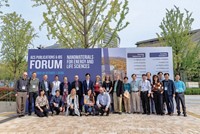Advertisement
Grab your lab coat. Let's get started
Welcome!
Welcome!
Create an account below to get 6 C&EN articles per month, receive newsletters and more - all free.
It seems this is your first time logging in online. Please enter the following information to continue.
As an ACS member you automatically get access to this site. All we need is few more details to create your reading experience.
Not you? Sign in with a different account.
Not you? Sign in with a different account.
ERROR 1
ERROR 1
ERROR 2
ERROR 2
ERROR 2
ERROR 2
ERROR 2
Password and Confirm password must match.
If you have an ACS member number, please enter it here so we can link this account to your membership. (optional)
ERROR 2
ACS values your privacy. By submitting your information, you are gaining access to C&EN and subscribing to our weekly newsletter. We use the information you provide to make your reading experience better, and we will never sell your data to third party members.
Biological Chemistry
你好 from Beijing
by Bibiana Campos Seijo
October 31, 2016
| A version of this story appeared in
Volume 94, Issue 43
I have just come back from Beijing, where I have been attending the American Chemical Society Publications symposium Innovation in Molecular Science. I hadn’t visited China for a few years so was pleased to be back and be able to witness the rapid pace of change that has been documented.
The three-day symposium was coorganized by ACS and the Institute of Chemistry of the Chinese Academy of Sciences.
The diversity of the panel of speakers at the symposium was excellent and refreshing. There was a good male-to-female ratio as well as national-to-international. Diversity applied not only to the speakers but also to the breadth of science discussed. The content was divided into five tracks that included the chemistry-biology interface, sustainable chemistry and energy, supramolecular self-assembly, molecular catalysis and selective synthesis, and functional molecular materials.
The track on molecular catalysis and selective synthesis was kicked off by Eiichi Nakamura from the University of Tokyo. His talk was a master class in iron catalysis and the electron microscopy methods his group has developed to study the course of chemical reactions, which he exemplified with a bucky ferrocene compound that had undergone a C–C bond reorganization.
In the chemistry-biology interface track, we saw, among many others, brilliant talks by the University of Utah’s Cynthia Burrows and Jinwoo Cheon of South Korea’s Yonsei University.
The focus of Burrows’s talk was DNA structure and folding dynamics. She explained how her group has used a nanopore embedded in a lipid bilayer as a single-molecule analytical tool: Folded DNA structures are immobilized in the pore until they unfold; once they unfold, they translocate through the pore aided by an electrophoretic force. This allows her team to determine the distribution of different DNA folds as well as the speed at which they unfold.
Cheon talked about the use of magnetic nanoparticles and their potential application in sensing, targeting, and signaling of cells in selective and efficient ways. He focused on applications around the treatment of hearing disorders, an area that is in its infancy and that C&EN has covered in recent times.
One of the highlights from the sustainable chemistry and energy track was a talk about artificial photosynthesis by Peidong Yang of the University of California, Berkeley. During his talk, Yang stressed that although conversion of solar into chemical energy is a desirable goal and a hot research area, so far we have not succeeded at creating systems that are able to achieve this with the necessary efficiency, durability, and cost. He called for better design of light-harvesting materials as well as of catalysts, and he gave some examples of potential strategies—what he called cyborgian design, that is, interfacing biotic and abiotic components to create something that’s half machine, half life.
After the symposium had concluded, it was an honor to be able to participate in ICCAS’s 60th anniversary celebrations. The institute’s director, Deqing Zhang, led a series of talks, including ones by former directors such as Lilan Zhu, who after her stint as ICCAS director went on to lead China’s Ministry of Science & Technology. Other dignitaries included Jiannian Yao, president of the Chinese Chemical Society and vice president of the National Natural Sciences Foundation of China, as well as directors of Chinese Academy of Sciences centers and institutes around China, including Kuiling Ding, director of the Shanghai Institute of Organic Chemistry, and Tao Zhang, director of the Dalian Institute of Chemical Physics.
The event ended with a tour of a permanent museum about ICCAS that contains memorabilia such as books, papers, samples, and photographs of the many occasions that the institute has celebrated in the past 60 years. If you haven’t yet read the profile C&EN’s Mitch Jacoby wrote about ICCAS, I invite you to do that (Oct. 10, page 18). Here’s to another 60 years!
Views expressed on this page are those of the author and not necessarily those of ACS.




Join the conversation
Contact the reporter
Submit a Letter to the Editor for publication
Engage with us on Twitter